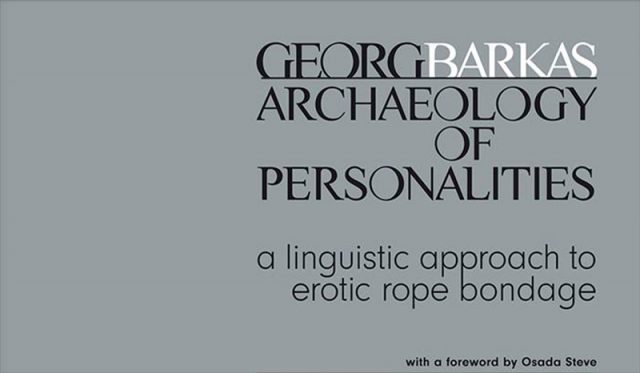 Georg Barkas has published a new book “Archeology of Personalities: a linguistic approach to erotic rope bondage.”
Georg Barkas has published a new book “Archeology of Personalities: a linguistic approach to erotic rope bondage.”
In “Archaeology of Personalities”, the author tries to fill the gap of a philosophical interpretation of erotic rope bondage. Starting from the vague perspective of bondage as some kind of communication, the study develops step by step a broad basis for an understanding of the power structures with a specific communication discourse. By deconstructing the contexts it ends up at erotic rope bondage being described through the metaphor of an interview. This image not only helps understanding existing ways of practicing erotic rope bondage but it enables to use erotic rope bondage itself as a tool for exploring each others personalities. The book also contains some personal approaches of Georg Barkas to the world of erotic rope bondage. He himself dedicated his life to Kinbaku, to practice it, to teach it and to celebrate it as something that is at once eroticism, art, engineering, and impactful human interaction. Georg Barkas holds a master’s degree in mathematical physics, and pursued a PhD in history and philosophy of science in Vienna and Berlin. His research was and is strongly influenced by the French poststructuralist movement. In 2014, Barkas quit academia to become a professional rope bondage artist and educator. Here he applies his academic history and curiosity to rope bondage.
Osada Steve has generously sent us the foreword he authored for the book:
Gone are the days when rope bondage was a simple matter of tying someone, somehow, no matter what. With the explosive growth in popularity of Shibari and Kinbaku, erotic rope bondage has now evolved into an interdisciplinary art form.
In the West there was first a thirst for understanding the technical matters of the various Japanese tying forms. This was followed by exploring ways to fill sessions with feeling, heart, and emotion – in order to better ‘connect’ with your tying partner. While it is easy to learn the technical intricacies of Shibari, it is the ‘connectivity’ aspects that often elude. Because they require empathy, compassion, truthfulness, and honesty – and, if you are the one who does the tying, it helps having the ability to listen to the signals emanating from your partner.
This leads us to the metaphor of the ‘interview’ and other linguistic concepts so aptly put forth by the author. When it comes down to it, the act of tying can be viewed as conversing in a different language. If you wish to communicate ethically, you will show respect to the one you are talking with by not interrupting, by giving time to formulate an answer, a thought. Tying as a form of dialog, not monolog. It is here where Georg Barkas is breaking new ground and delivers a profound message to us mortals.
Barkas, by the way, is the son of Hannibal. I am not Hannibal, but Barkas to me is like the son I never had. He also has the gift of making me oraculate. This has earned him a place in my heart, and I am proud and honored to have him as a licensed instructor of Osada-ryu.
Osada Steve
April 2017







